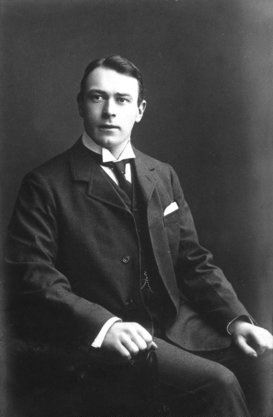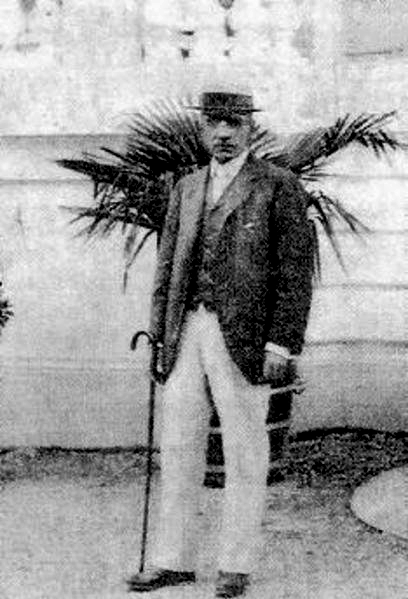Titanic steaming down the River Lagan shortly after completion. Image from the Steve Raffield collection/
voices of a tragedy
letters from the rms titanic
By Michael Brady
Titanic needs no real introduction because the story has entered the popular vernacular. She has become a symbol of Edwardian arrogance, emblematic of an era of nearly unbridled aspirations and an unshakeable faith in technology. After a century of sensationalism and mythologising it is easy to forget that Titanic's passengers and crew were ordinary people undertaking a fairly routine crossing when they were abruptly confronted with sure death on a calm, moonless night. All too often focus is placed on the ship itself - as an illustrator of ocean liners I am definitely guilty of this too - and the human stories are almost seemingly forgotten about.
This month on 'Tales from the Weather Deck' I have compiled a short list of correspondences from some victims of the Titanic disaster. We have heard and read survivor testimonies but the dead remain silent; only by the precious few remaining letters and postcards written and posted from the ship before she set off can we piece together the thoughts and impressions of those passengers of hers who would not make it home to their loved ones. Theirs are the voices of a tragedy.
thomas andrews
Andrews has become a legend, not just because he headed the design of Olympic and Titanic but because of his selfless actions when his creation began to founder. In 1912 Andrews, originally from Comber, Ireland, was 39 years old and working hard at his dream job - a career he had shaped over the course of 23 years at the Harland and Wolff shipyard. He had begun as a sixteen-year-old apprentice with the Yard back in 1889 at the Joiner's shop and ended up the Manager of Construction Works in 1901. Andrews was a fastidious hard-worker but he was also well-liked by the Yard's labourers for his geniality and thoughtfulness. Signs of Andrew's considerate nature can even be found on the Titanic wreck today; installed at the top of the ship's twin firemen's ladders can be found a drinking fountain, ideally-placed by the Designer to quench the thirst of soot-coated Stokers at the end of a long shift. In 1908 Andrews, having overseen the construction and launch of hundreds of ships, was appointed managing director and head of Harland and Wolff's drafting department. So it was that in 1909, when White Star Line approached the Firm to commence designing a trio of new super-liners, Andrews was to be the vessels' chief planner.
Andrews fell in love with Helen Barbour, "Nellie", and shocked her with an engagement ring one night in 1906. The next day he penned a heartfelt letter to her; "My Dear Nellie, I cannot tell you how much it grieves me to feel that I frightened or gave you any annoyance last night..." Andrews' fears were misplaced though; the two were married in 1908 and Helen soon fell pregnant. One night Thomas took Nellie to the deserted slipway where Titanic sat unfinished and soon-to-be launched. There can be no question that Andrews was proud of his ships. In his final letter home, Andrews wrote that "The Titanic is now about complete and will I think do the old Firm credit tomorrow when we sail". Indeed, he spent much of the voyage penning notes to improve on Titanic's design for the third and final sister, Britannic.
Above: Thomas Andrews’ ultimate creation; White Star Line’s Titanic. Learn more about Titanic here.
The notes he kept on Titanic are lost to the sea but we can get some sense of Andrews' attention to detail from those he made for Olympic just a year prior;
- Would propose fitting eleven additional four seated tables in 1st class restaurant as per plan, this room being short of table accommodation.
- A screen to be an improvement if fitted on the side of the restaurant/buffet SUPT entrance door so as to prevent passengers from seeing behind the buffet.
- Linoleum tiles not to be fitted in Captain’s sitting room in which a full room carpet has been provided.
- Sponge holders to be fitted in the private bathrooms on B and C decks where these have been omitted.
When Titanic struck the iceberg, Andrews famously conferred with Captain Smith and confirmed that the vessel would soon be lost. His actions that night are well-documented and were extensively covered by the press - rather than save his own life, Andrews distributed lifebelts to passengers and urged the importance of their use. He seems to have been one of the few to give Third Class passengers, trapped below in the ship's labyrinthine corridors and passageways, any thought at all and he set about guiding groups of them up to the Boat Deck for evacuation. He was last seen in the vicinity of the bridge when the vessel took her final plunge from the surface and his body was never recovered.
Nellie was devastated by the loss of her husband. Her daughter, from a second marriage, recalls that "She was obviously very, very fond of him. I think it was a true love match. He must have been brilliant. But the other thing that comes out so often is his real affection for the workers. He told Nellie when they were driving out of the shipyard one day together that all the workers who were coming out were his mates. He was so very popular and dearly loved I think by so many people."
Above: Nellie (left), Thomas and their baby girl Elizabeth - known as ‘Elba’.
Image from Encyclopedia Titanica
ramon Artagaveytia
There are a number of famous coincidences regarding the Titanic sinking, but one which is particularly tragic is the little-known story of Mr Ramon Artagaveytia from Uruguay. Artagaveytia was born in 1840 and, as a young man, survived a terrible disaster at sea. On Christmas Eve, 1871, Ramon was aboard the steam ship 'America', engaged in a race against another vessel into Montevideo harbour. It is thought that excess pressure on the ship's boilers led to a fire and 'America' was soon engulfed. Of 164 passengers, only 65 survived the inferno - many were badly burned. Artagaveytia jumped for his life, was fished from the sea and was emotionally distressed by what he had experienced. Writing to a cousin, Ramon explained that "Nightmares keep tormenting me. Even in the most quiet trips, I wake up in the middle of the night with terrible nightmares and always hearing the same fateful word: Fire! Fire! Fire!...I have even gotten to the point where I find myself standing in the deck with my lifebelt on...'
In 1905 Ramon took over the family farm in Argentina, living a relatively peaceful life. It was in 1912 - 41 years after America was lost - that Artagaveytia decided to face his fears again and travel, by ship, to visit family in Europe. Fascinated by the technological marvels present on modern liners, he wrote that; "You can't imagine, Enrique, the security the telegraph gives. When the America sank, right in front of Montevideo, nobody answered to the lights asking for help. The ones that saw us from the ship Villa del Salto, did not answer to our light signals. Now, with a telephone on board, that won't happen again. We can communicate instantly with the whole world." With the successful trip behind him, Ramon booked passage for home aboard the latest steamer; White Star's Titanic. Boarding at Cherbourg he wrote some final letters home;
"I closed my eyes and went onboard in this huge ship. One of the carriers took my suitcase, and brought it to third floor. We went to the dining room. saloon C. My cabin is very comfortable. It is heated by electricity. It is on during the night because it is very cold."
So it was that, after forty years, Mr Artagaveytia was to be confronted with disaster at sea once more. With word quickly spreading throughout the ship of some kind of trouble, Ramon and two shipboard companions made their way to the Boat Deck where they were spotted by a fellow First Class Passenger, Elmer Taylor;
'About halfway up the flight (on the way up to the boat deck), there were two gentlemen, one on either side, leaning against the balustrade and, from outward appearance, looked more dead than alive. We [Taylor and his wife Juliet ], had been introduced to these two fine looking men by a mutual friend on the platform in Waterloo Station. They were from Buenos Aires, Argentina. They could not speak English and we could not speak Spanish. As we casually met day by day, we would all speak our native language, smile and pass along, none of us understanding what the other one said. At this meeting, we repeated the usual salutations, shook hands and assured them there was no danger, smiled and proceeded on our way, to carry the fear they exhibited on their faces for the remainder of my life. How terrifying it must have been to those who did not have faith in the wonderful engineering skill displayed in building this massive unsinkable steamer...'
A week following the Titanic's sinking, the cable vessel Mackay-Bennett, on a mission to recover bodies left behind on the surface, recovered that of Ramon Artagaveytia - his remains were returned to Montevideo where he was interred.
Image from Encyclopedia Titanica
edgar andrew
Andrew, 17, was born in Argentina to British parents. Having left the Americas to study in Bournemouth, England, the lad was invited by his brother Alfredo to attend his wedding in the USA and stay for a working position in New Jersey. He booked passage aboard Oceanic but, as with many others, fate was to intervene; a coal-strike saw many of White Star Line's ships temporarily moth-balled and the teenager was transferred to Titanic. In a letter to a friend, Josefina Conway, Andrew opined;
"You figure Josey I had to leave on the 17th this (month) aboard the "Oceanic", but due to the coal strike that steamer cannot depart, so I have to go one week earlier on board the "Titanic". It really seems unbelievable that I have to leave a few days before your arrival, but there's no help for it, I've got to go. You figure, Josey, I am boarding the greatest steamship in the world, but I don't really feel proud of it at all, right now I wish the 'Titanic' were lying at the bottom of the ocean."
Those prophetic words would likely haunt Conway for the rest of her life. Edgar was lost in the disaster and his body was never found. Edwina Troutt, then-27 years old, had met Edgar on-board as the two shared the same table for meals. Years later, having never discussed the sinking, she finally broke her silence and recalled that on the night of the sinking she had come across Andrew. The teenager was wearing his life-belt and, although she was ten years older than him, Edgar took it off and gave it to her. In 2001, 89 years after his death, Edgar's neatly-packed suitcase was discovered lying on the sea floor at the Titanic wreck site as if waiting to be retrieved by its long-lost owner.
Below: Edgar Andrews’ suitcase is retrieved from the sea bed.
Image from Encyclopedia Titanica
percy bailey
Titanic's Second Class was comprised of a wide spectrum of people with passenger occupations varying from clerks and shopkeepers to business owners and schoolmasters. Percy Bailey, 18, of Cornwall, followed in his father's footsteps and became a butcher's assistant. In 1912 Percy received a once-in-a-lifetime opportunity; a friend of his father's based out of Ohio offered him a precious butcher's apprenticeship. Excitedly, Bailey went to book a crossing on Oceanic but changed to Titanic when he learned a number of his friends were crossing too. Boarding Titanic at Southampton on April 10 he sent this touching letter home to his parents;
Dear Father and Mother,
We arrived on board this morning after a nights rest at Southampton... Well dear Mother, I suppose you are missing me but don't be downhearted, old dear Percy will be behaved to you as a son ought to treat his Mother and Father. This going away from home will make me a better man and try and lead a good life. The Titanic is a marvel I can tell you I have never seen such a sight in all my life, she is like a floating palace, everything up to date. I hope you are all well as it leaves me at present.
Father I shall never forget your kindness, you have don more for me than many Fathers have done for their sons. Well dear parents I don't think there is any more news I can tell you now, kiss Grandma for me and tell her I am sorry for all my wicked thoughts which I said to her, but never again, will I cheek her.
Give my best love to all who ask for me and tell Ethel to come and see you any time. I will draw my letter to a close hoping you one and all are quite well.
I remain your loving son
Bailey was lost when Titanic sank and his body was never recovered. Across the ocean, at the destination Percy never reached, flags fluttered at half mast and his uncle recalled how proud the young man had been to be sailing on Titanic's maiden voyage.
Image from Encyclopedia Titanica
alexander holverson
Holverson, an American businessman, was travelling First Class with his wife Mary. The pair were returning home from a long vacation which had seen them travel throughout South America before sailing for a stay in England. On April 13, when Titanic was mid-ocean and only a day from disaster, Holverson penned his mother a letter on ship-board stationery intending to send it upon landing at New York;
My dear Mother – We had good weather while we were in London. It is quite green and nice in England now. This boat is giant in size and fitted up like a palatial hotel. The food and music is excellent and so far we have had very good weather. If all goes well we will arrive in New York Wednesday A.M. I am sending you a postcard of the ship and also a book of postcards showing the inside. We have not had any news since we left New York Jan. 6th so we do not know what has been going on since we left. Mary’s sister was ill when we left and had an operation performed out of New York. Mary had a letter from Mr. Berry at Buenos Aires which stated that she was getting on fine but have not heard anything since. We have been so far away that it has been hard to reach us with mail. Mr. and Mrs. John Jacob Astor is on this ship. He looks like any other human being even tho he has millions of money. They sit out on deck with the rest of us and are very democratic. Well I guess I will write more another time.
The Astors, probably the most well-known passengers aboard and definitely the wealthiest, were returning to America after having fled a scandal; John Jacob Astor had married a woman 30 years his junior and New York society was in a hubbub.
Holverson’s letter would never be properly posted - after ensuring Mary was put into a lifeboat he had remained on the ship and perished. His body was among those recovered and identified by Mackay-Bennett in the week following the tragedy and the letter was found inside his coat pocket.
Below: Alexander and Mary Holverson leaving for Europe in 1911.
Image from Encyclopedia Titanica
wallace hartley
Another hero of the Titanic story, Wallace Hartley was Titanic’s band-leader. The ship actually featured two separate ensembles- a more informal trio, which would play at the B-Deck entrance to the Ship’s ‘A La Carte’ Restaurant, and a formal quintet led by Hartley who played in larger public spaces before or after meals. The musicians were not White Star employees but contractors of C.W. & F.N. Black who supplied orchestras to many ships afloat at the time.
Wallace Hartley’s actions on the night of the disaster have passed into legend; the two bands combined and, under Hartley’s leadership, played waltzes and ragtime to calm passengers as they evacuated the ship. Not one of the musicians survived.
On April 10, the day of Titanic’s sailing from Southampton, Hartley sent a quick note home ;
My dear parents,
Just a line to say we have got away all right. It’s been a bit of a rush but I am just getting a little settled. This is a fine ship & there ought to be plenty of money on her. I’ve missed coming home very much & it would have been nice to have seen you all if only for an hour or two, but I couldn’t manage it. We have a fine band & the boys seem very nice. I have had to buy some linen & I sent my washing home today by post. I shall probably arrive home on the Sunday morning. We are due here on the Saturday. I’m glad mother’s foot is better.
Wallace
Hartley’s body was recovered by Mackay-Bennett still in possession of his violin case. The violin itself had been a gift from his fiancee Mary in 1910 and it was returned to her.
One final note deserves publishing; that of 10 year-old Mary ‘May’ McMurray. On April 13 she had sent a letter to her father, William, from the family home in Liverpool. William signed onto Titanic as a Saloon Steward and was lost in the ensuing disaster. This touching letter, repeated here with young May’s original spelling errors, stands as a poignant reminder, not just of those who would never return home, but of the beloved families they left behind.
Dear Father
It seems ages since I last seen you. I wish we where in Southampton with you it is very lonely without you Dear Father I have not been so very well I have had a a bad throat hoping I will soon get better for Mama worries so much little Ernie as not been so well but he as got better now hoping you are keeping well dada so ta love from Ivy and Ernie thank dada for the presents love from all dada hoping to see you soon with love from Ivy and May and Ernie xxxxxxxxxx kisses for dada x
Dada this is my first letter
William McMurray. Image from Encyclopedia Titanica
This article would not have been possible without the tireless efforts of the contributors to Encyclopedia Titanica. That website is second-to-none in providing thoroughly-researched material on Titanic’s passengers and crew. If you would like to learn more about the passengers mentioned in this article, please follow the links below;
These, and other letters, can be found here at the Diary File - a fantastic historical resource for letters and journal entries.
If you enjoyed this article or would like to offer some feedback, please contact us via email at info@linerdesigns.com or visit our Contact page.






















